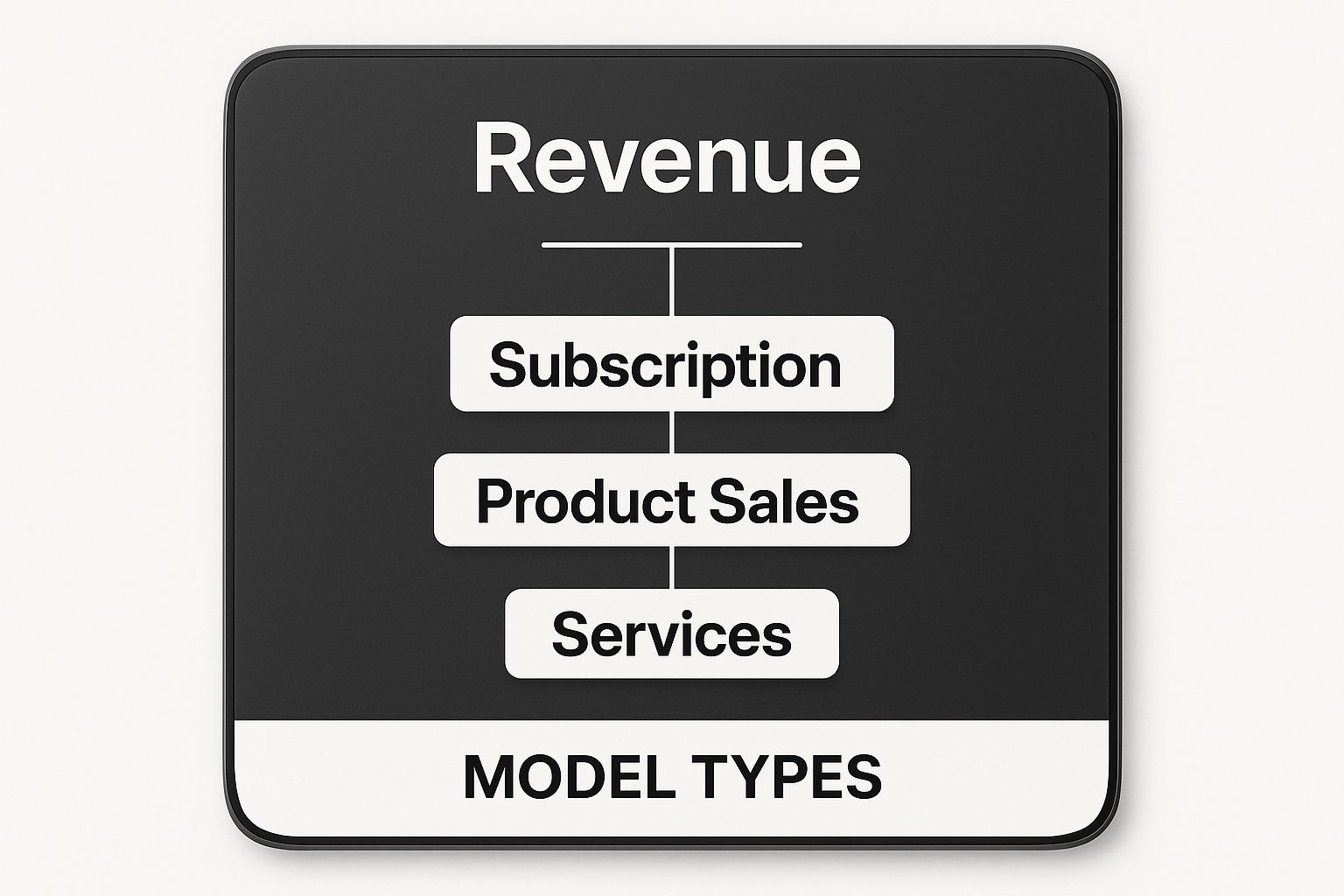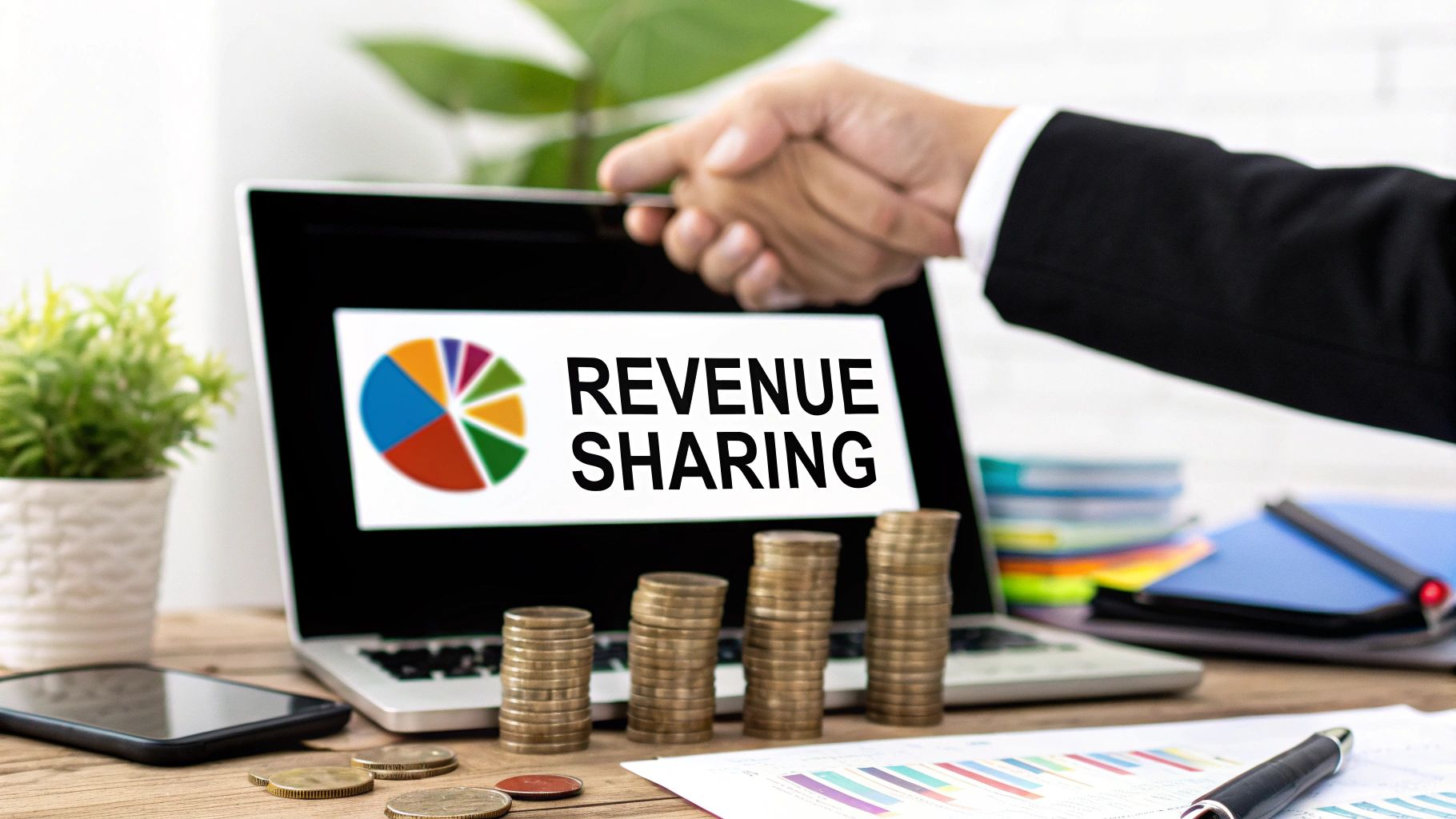Revenue sharing is a pretty simple concept at its heart. It’s a deal where partners agree to split the money they make from a joint project. Think of it like a band splitting the ticket sales from a concert—if the show is a hit, everyone who played a part gets a cut. This setup creates a powerful incentive for everyone to pull in the same direction, turning a simple business arrangement into a true partnership.
What Are Revenue Sharing Models, Really?

At its core, a revenue sharing model is just a formal agreement on how to divvy up the gross revenue between two or more people or companies. This isn't about one-off payments or fixed fees. It’s about building an ongoing relationship where if one partner wins, the other one does too. Instead of just paying someone for a service, you’re both invested in growing the pie together.
This kind of thinking is absolutely crucial today, especially in fast-moving areas like affiliate marketing, the creator economy, and Software-as-a-Service (SaaS). A generic, one-size-fits-all payment structure just doesn't cut it when the value each partner brings to the table is so different.
Key Takeaway: The whole idea behind revenue sharing boils down to two things: shared risk and shared reward. When everyone has skin in the game, their goals naturally line up. This leads to much stronger collaboration and a deeper commitment to making the venture a success.
Why These Agreements Are So Important
Picking the right revenue sharing structure is a huge strategic decision, not just a financial one. It can genuinely make or break a partnership. A well-crafted model gets affiliates excited to drive more sales, motivates developers to innovate on your platform, and inspires creators to produce their best work.
You see these models everywhere in subscription-based businesses. Take the global SaaS industry, for example. It’s a perfect case study in recurring revenue and is expected to grow to a market volume of $793.10 billion by 2029. This massive growth is partly fueled by smart partnership models that are essential for scaling. You can dig deeper into these SaaS industry trends to see just how big the impact is.
Ultimately, a good revenue sharing agreement sets the stage for a transparent and lasting partnership. It makes expectations clear, defines what success looks like, and guarantees that everyone is fairly rewarded for the value they create. It’s the engine that powers mutual growth.
Decoding Common Revenue Sharing Structures
Jumping into a partnership without knowing the nuts and bolts of the revenue sharing model is a recipe for confusion. Each structure is a different playbook for winning together, built for specific goals and relationships. Let's break down the most common frameworks you'll encounter.
Think of these models as the "rules of the game" you and your partners agree on. Getting this right from the start means everyone knows exactly how they get paid and what success looks like.
This chart gives you a bird's-eye view of how these models are layered, starting with the most basic splits and moving into more specialized arrangements.

As you can see, everything starts with one foundational choice: whether you're splitting revenue from the top line or the bottom line.
Gross vs. Net: The Foundational Choice
Before you get into the weeds of percentages or tiers, you have to answer a huge question: are we sharing revenue or profit? This single decision completely changes how cash flows and who shoulders the risk.
- Gross Revenue Split: This is a cut of the "top-line" revenue. It’s the total cash generated from a sale, before any costs like marketing, ads, or platform fees are taken out. It's simple, transparent, and very easy to calculate.
- Net Revenue (or Profit) Split: This model shares the "bottom-line" profit—the money that’s left after all the associated business costs are paid. This approach feels fairer to many, as it accounts for the actual expenses needed to make the sale happen.
The choice is a big deal. A gross split is all about driving sales volume, period. A net split, on the other hand, rewards efficiency and smart spending just as much as it rewards the sale itself.
A partner who only handles sales might lobby hard for a gross split because they have no control over costs. But if you're the one managing the budget and operations, you'll almost always favor a net split to make sure the bills are paid before you share the profits.
Percentage-Based And Tiered Models
Once you've settled on gross versus net, you can layer on more specific commission structures. The two that power most affiliate and referral programs are the simple percentage split and the more dynamic tiered model.
A fixed-percentage split is as straightforward as it gets. A partner earns a set percentage—say, 20%—of every single sale they refer. It’s predictable and easy for everyone to track, making it a perfect fit for many basic affiliate relationships.
A tiered model introduces a performance incentive. Think of it like a video game where partners can "level up" to unlock better rewards.
Here’s a common example:
- Tier 1: Earn 15% commission on your first 10 sales each month.
- Tier 2: Hit 11-50 sales and your commission bumps up to 20%.
- Tier 3: Drive more than 50 sales and you earn a 25% commission.
This structure is a powerful motivator. It gives partners a clear path to earning more, which directly encourages them to ramp up their efforts. It's an especially effective approach for building a high-growth SaaS affiliate marketing program. To set competitive tiers, it's also helpful to research current influencer compensation rates to see what top performers in your niche might expect.
To give you a clearer picture, here’s a quick comparison of the most common models.
Comparing Common Revenue Sharing Models
This table breaks down the most popular revenue sharing models, showing you at a glance how they work and where they fit best.
| Model Type | How It Works | Best For | Potential Pitfall |
|---|---|---|---|
| Gross Revenue Split | A percentage of total sales revenue is shared before deducting any costs. | Simple partnerships where one partner drives sales and the other handles all operations and expenses. | The business owner bears all the risk of high costs, potentially paying out commissions on unprofitable sales. |
| Net Revenue (Profit) Split | A percentage of profit is shared after all associated costs are deducted from revenue. | Complex joint ventures where both partners share in operational costs and risks. | Can lead to disputes over what qualifies as a deductible "cost" if not clearly defined upfront. |
| Fixed-Percentage Split | A constant, unchanging commission rate (e.g., 20%) is paid on every sale. | Predictable, stable affiliate programs where the goal is consistent, steady growth. | May not motivate high-performers to push their limits, as the reward for 100 sales is the same rate as for 1 sale. |
| Tiered Model | The commission percentage increases as the partner meets higher performance targets (e.g., sales volume). | Motivating partners to scale their efforts and rewarding top performers for driving significant growth. | Can be more complex to track and manage; lower tiers might feel unmotivating if set too low. |
Ultimately, there's no single "best" model—only the one that's best for your business, your partners, and the specific goals you're trying to achieve together.
The Rise of Hybrid and Advanced Models

Sometimes, the standard revenue sharing playbooks just don't cut it. As partnerships become more sophisticated, sticking to a simple percentage or a basic tier system can feel like trying to fit a square peg in a round hole. The smartest companies are getting creative, moving beyond off-the-shelf solutions to build hybrid models.
Think of it like a custom-built engine. These innovative structures cherry-pick the best elements from different frameworks to create a partnership agreement that’s both flexible and powerful. It’s an acknowledgment that one-size-fits-all rarely works when motivations and goals are complex. By blending models, you can reward partners for hitting sales targets while also encouraging long-term loyalty and strategic input.
Blending Subscriptions with Ad Revenue
A perfect example of a hybrid model in action is the ad-supported subscription, which has completely reshaped the media landscape. This approach brilliantly combines the steady, predictable cash flow of subscriptions with the massive potential of advertising dollars. It’s a way to serve two very different types of customers at the same time.
You've seen this everywhere with major streaming services. Giants like Netflix, Disney+, and Amazon Prime Video all rolled out hybrid plans that offer a lower subscription price in exchange for watching a few ads. And it's working. Projections show that by 2028, advertising will account for a whopping 28% of global streaming revenues, up from 20% in 2023. If you want to dive deeper, you can explore the data on how AVOD is reshaping streaming profits to see just how big this trend is.
This model creates a true win-win-win situation:
- Price-conscious consumers get to enjoy premium content without the premium price tag.
- The company attracts a much larger audience and taps into a lucrative new income source.
- Advertisers gain access to a highly engaged audience they couldn't otherwise reach.
Equity Sharing for Long-Term Alignment
When the stakes are incredibly high, particularly in the fast-paced world of tech startups, an even more powerful model is taking center stage: equity sharing. Here, instead of just cash commissions, a key partner or foundational employee is offered actual ownership in the business. It’s not just a paycheck; it’s an invitation to the owner’s table.
An equity share fundamentally changes the dynamic of a partnership. It transforms the relationship from a transactional one into a deep, strategic alliance where all parties are invested in the company's long-term valuation and ultimate success.
This method is so effective because it aligns everyone's incentives in the most profound way possible. A partner with equity isn't just thinking about their commission on the next sale. They're thinking about building a sustainable, valuable company over the next five or ten years. It’s the ultimate form of "we're in this together," making it the gold standard for locking in foundational partners who are absolutely critical to a company's future.
Choosing the Right Model for Your Business
Picking the right revenue sharing model isn't just a box to check; it’s where your strategy hits the real world. A great model does more than just split the cash—it aligns everyone's incentives, keeps risks in check, and builds a solid foundation for a partnership that actually works. You have to move past the standard templates and ask some tough, strategic questions about what you really want to achieve.
This whole process has to start with some honest self-reflection. Before you even start crunching numbers or debating percentages, you need a crystal-clear picture of what success looks like for your business and for your partners. Getting this right is the bedrock of any fair and effective agreement.
Key Questions to Guide Your Decision
Think of this as your pre-launch checklist for any partnership. Answering these questions honestly will light up the path to the best possible revenue sharing structure for your specific needs.
- What's the main goal here? Are you chasing explosive, fast-paced growth, even if it's costly? Or is the focus on building slow, steady, and sustainable profit over the long haul? A model built for hyper-growth (like an aggressive tiered system) is a world apart from one designed for stable profitability (like a simple net profit split).
- What’s the timeline for this partnership? Is this a quick, one-off campaign, like a promotion for a product launch? Or are you building a strategic alliance that you hope will last for years? Short-term goals often work well with simple gross splits, whereas long-term ventures might call for something more substantial, like equity sharing.
- What unique value is each partner bringing to the table? Maybe one partner is a marketing machine, driving all the sales, while the other handles the entire product and operations side. The partner driving sales, who has zero control over costs, is naturally going to want a piece of the gross revenue. On the flip side, the partner managing the budget will insist on a net profit share to make sure all expenses are covered first.
Going through this exercise prevents you from just grabbing a generic model off the shelf that doesn't really fit. It forces a crucial conversation about expectations and contributions right from the start.
Matching the Model to the Scenario
Once you're clear on your goals, you can start connecting specific situations to the right models. The structure you choose should feel like a natural extension of your strategy, not something bolted on as an afterthought.
For example, a SaaS company trying to pour fuel on its new affiliate program would get a massive boost from a tiered commission model. This setup directly encourages affiliates to ramp up their efforts, rewarding top performers with better commission rates as they send more customers your way. It’s a powerful growth engine powered by clear, motivating targets.
Now, picture a totally different scenario: a high-stakes joint venture where two companies are co-developing a brand-new piece of software. In this case, a net profit split is almost always the way to go. This model guarantees that all the costs—development, marketing, operations, you name it—are paid off before a single dollar of profit is distributed. It's a fundamentally fair arrangement where both parties share the risks and the rewards right down the middle.
The core principle is simple: the flow of money should follow the flow of value and risk. The partner who contributes more or takes on greater risk should be compensated accordingly.
When you're weighing your options, it's crucial to map out the potential financial outcomes for everyone involved. This includes getting a firm grip on the social media ROI if marketing channels are part of the shared effort. This big-picture view ensures the model you land on isn't just fair on paper, but financially smart for everyone. In the end, the right agreement isn't just about splitting money; it’s about forging a true partnership that gets real, measurable results for everyone at the table.
Avoiding Common Partnership Pitfalls
A solid revenue-sharing deal is about so much more than just the numbers. It’s about building a real partnership grounded in trust, transparency, and a shared vision. Without that, even the most generous percentages can end in conflict and frustration.
The single most important thing you can do? Get it all in writing. Handshake deals and email threads just don’t cut it when money is on the line. A formal, written partnership agreement is your roadmap and your rulebook, preventing misunderstandings by spelling out every critical detail. This is where you need to be relentlessly specific.
Defining Your Terms Clearly
Vague language is the silent killer of partnerships. Your agreement needs to slam the door shut on any potential for misinterpretation.
- What exactly is ‘Revenue’? Are we talking about the total sale price (gross revenue)? Or is it the amount left after subtracting refunds, chargebacks, and transaction fees (net revenue)?
- What are ‘Costs’? If you’re splitting net revenue, you have to define which expenses are coming off the top. Get specific about marketing costs, operational fees, or any other shared overhead.
- What is the ‘Payment Cycle’? Don't just say "monthly." Define the exact schedule for payouts—for instance, "on the 15th of every month for the previous month's earnings."
Getting these definitions wrong is one of the most common—and avoidable—reasons partnerships sour.
Think of your partnership agreement like a pre-flight checklist. It forces you to think through all the potential problems on the ground, so you can have a much smoother flight once you’re in the air.
Another huge landmine is accidentally creating misaligned incentives. If your model rewards one partner for an action that ultimately hurts the business or the other partner, you’ve built a system that’s designed to fail. This is where transparent reporting is absolutely essential. Both sides need access to a shared dashboard or detailed reports showing performance data. This is a fundamental part of effective affiliate program management.
Unfortunately, this lack of transparency is a widespread issue. A 2025 analysis of data-sharing initiatives revealed that most fail to establish clear frameworks, which keeps partners from seeing proportional benefits. Experts in the report stressed that a lack of robust, transparent revenue-sharing is a major obstacle to success. You can dig deeper into why clear revenue frameworks are crucial for any collaboration.
Finally, too many partners forget to plan for the end. Every agreement must include an exit strategy. What happens if one person wants out? What if the business gets acquired or pivots to a new model? Thinking through these scenarios from day one gives everyone a clear and fair process for winding things down if it becomes necessary, protecting both the business and the relationship.
Answering Your Revenue Sharing Questions
Even with a great plan on paper, the real world of revenue sharing throws up its own set of challenges. It’s one thing to sketch out a model, but it's another thing entirely to handle the day-to-day grind of tracking, payments, and partner agreements. This section is all about tackling those common, practical questions head-on.
Think of this as the final checklist before launch. We'll give you the straightforward answers you need to build your partnerships on a foundation of trust and clarity from day one.
What’s the Go-To Model for SaaS Affiliate Programs?
For most SaaS companies, the gold standard is a recurring, percentage-based commission. Instead of a one-time finder's fee, this model pays the affiliate for as long as the customer they brought in stays subscribed. It's a game-changer.
This approach creates a powerful alignment. You want to reduce churn and increase customer lifetime value (LTV), and this model makes your affiliates want the exact same thing. It incentivizes them to find high-quality, loyal customers, not just quick sign-ups who disappear after a month. A common rate you'll see is 20-30% of the monthly subscription fee, paid out every single month.
How Can We Actually Track and Manage Payouts?
Trying to track sales and calculate commissions in a spreadsheet is a disaster waiting to happen. It's slow, riddled with potential errors, and a surefire way to erode trust with your partners. The only real answer here is modern affiliate management software.
These platforms automate the entire headache:
- Unique Tracking Links: Every partner gets a unique link, so you know exactly who sent which customer.
- Real-Time Dashboards: You and your affiliates can see clicks, conversions, and earnings as they happen. No more guessing games.
- Automated Calculations: The software does all the math for you, even for complex recurring or tiered models, eliminating human error.
- Simplified Payouts: Most platforms connect to payment gateways, letting you pay all your affiliates at once with just a few clicks.
Can We Change a Revenue Sharing Agreement Later?
Yes, but you have to do it the right way—ethically and carefully. Your agreement is a contract, and you can't just change the terms on your own whenever you feel like it. Any changes need to be agreed upon by everyone involved.
The best way to handle this is to plan for it from the start. Include a "Modification Clause" or "Amendment Clause" in your original agreement that spells out the process for making changes. Usually, this involves:
- Putting the proposed change in writing.
- Discussing it with your partners to get their feedback and buy-in.
- Getting everyone to sign a formal, written amendment to the contract.
Key Insight: Don't lock yourself in. By building a little flexibility into your initial agreement, you give yourself the room to adapt as your business grows without burning bridges or landing in legal trouble.
Of course, a great model is only half the battle; you also need great people. For more on this, read our guide on how to recruit affiliates and build a program that truly performs.
Ready to launch a powerful affiliate program directly inside your SaaS? Refgrow makes it simple. Embed a fully native, customizable affiliate dashboard into your app with just one line of code and start growing with our network of active promoters. Learn more and get started at https://refgrow.com.

